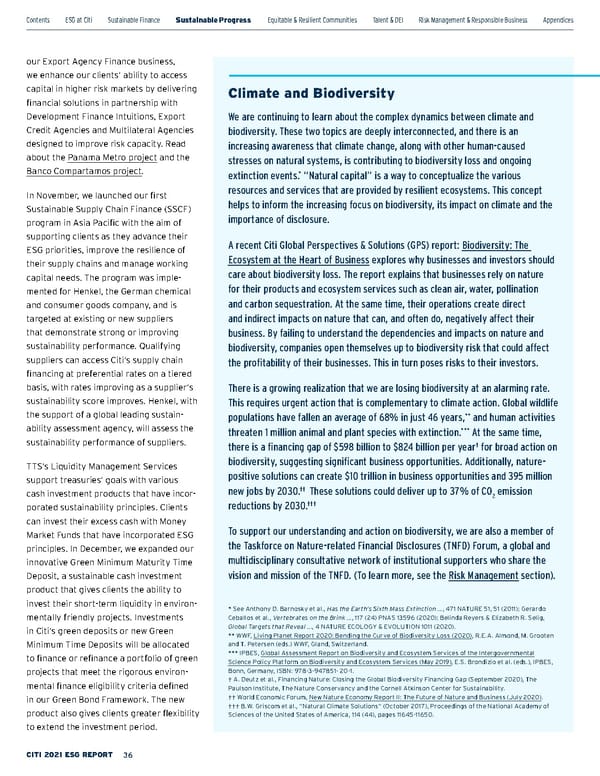Climate and Biodiversity We are continuing to learn about the complex dynamics between climate and biodiversity. These two topics are deeply interconnected, and there is an increasing awareness that climate change, along with other human-caused stresses on natural systems, is contributing to biodiversity loss and ongoing extinction events. * “Natural capital” is a way to conceptualize the various resources and services that are provided by resilient ecosystems. This concept helps to inform the increasing focus on biodiversity, its impact on climate and the importance of disclosure. A recent Citi Global Perspectives & Solutions (GPS) report: Biodiversity: The Ecosystem at the Heart of Business explores why businesses and investors should care about biodiversity loss. The report explains that businesses rely on nature for their products and ecosystem services such as clean air, water, pollination and carbon sequestration. At the same time, their operations create direct and indirect impacts on nature that can, and often do, negatively affect their business. By failing to understand the dependencies and impacts on nature and biodiversity, companies open themselves up to biodiversity risk that could affect the profitability of their businesses. This in turn poses risks to their investors. There is a growing realization that we are losing biodiversity at an alarming rate. This requires urgent action that is complementary to climate action. Global wildlife populations have fallen an average of 68% in just 46 years, ** and human activities threaten 1 million animal and plant species with extinction. *** At the same time, there is a financing gap of $598 billion to $824 billion per year † for broad action on biodiversity, suggesting significant business opportunities. Additionally, nature- positive solutions can create $10 trillion in business opportunities and 395 million new jobs by 2030. †† These solutions could deliver up to 37% of CO 2 emission reductions by 2030. ††† To support our understanding and action on biodiversity, we are also a member of the Taskforce on Nature-related Financial Disclosures (TNFD) Forum, a global and multidisciplinary consultative network of institutional supporters who share the vision and mission of the TNFD. (To learn more, see the Risk Management section). * See Anthony D. Barnosky et al., Has the Earth’s Sixth Mass Extinction ... , 471 NATURE 51, 51 (2011); Gerardo Ceballos et al., Vertebrates on the Brink ... , 117 (24) PNAS 13596 (2020); Belinda Reyers & Elizabeth R. Selig, Global Targets that Reveal .. ., 4 NATURE ECOLOGY & EVOLUTION 1011 (2020). ** WWF, Living Planet Report 2020: Bending the Curve of Biodiversity Loss (2020) , R.E.A. Almond, M. Grooten and T. Petersen (eds.) WWF, Gland, Switzerland. *** IPBES, Global Assessment Report on Biodiversity and Ecosystem Services of the Intergovernmental Science Policy Platform on Biodiversity and Ecosystem Services (May 2019) , E.S. Brondizio et al. (eds.), IPBES, Bonn, Germany, ISBN: 978-3-947851- 20-1. † A. Deutz et al., Financing Nature: Closing the Global Biodiversity Financing Gap (September 2020), The Paulson Institute, The Nature Conservancy and the Cornell Atkinson Center for Sustainability. †† World Economic Forum, New Nature Economy Report II: The Future of Nature and Business (July 2020) . ††† B.W. Griscom et al., “Natural Climate Solutions” (October 2017), Proceedings of the National Academy of Sciences of the United States of America, 114 (44), pages 11645-11650. our Export Agency Finance business, we enhance our clients’ ability to access capital in higher risk markets by delivering financial solutions in partnership with Development Finance Intuitions, Export Credit Agencies and Multilateral Agencies designed to improve risk capacity. Read about the Panama Metro project and the Banco C ompartamos p roject . In November, we launched our first Sustainable Supply Chain Finance (SSCF) program in Asia Pacific with the aim of supporting clients as they advance their ESG priorities, improve the resilience of their supply chains and manage working capital needs. The program was imple - mented for Henkel, the German chemical and consumer goods company, and is targeted at existing or new suppliers that demonstrate strong or improving sustainability performance. Qualifying suppliers can access Citi’s supply chain financing at preferential rates on a tiered basis, with rates improving as a supplier’s sustainability score improves. Henkel, with the support of a global leading sustain - ability assessment agency, will assess the sustainability performance of suppliers. TTS’s Liquidity Management Services support treasuries’ goals with various cash investment products that have incor - porated sustainability principles. Clients can invest their excess cash with Money Market Funds that have incorporated ESG principles. In December, we expanded our innovative Green Minimum Maturity Time Deposit, a sustainable cash investment product that gives clients the ability to invest their short-term liquidity in environ - mentally friendly projects. Investments in Citi’s green deposits or new Green Minimum Time Deposits will be allocated to finance or refinance a portfolio of green projects that meet the rigorous environ - mental finance eligibility criteria defined in our Green Bond Framework. The new product also gives clients greater flexibility to extend the investment period. Contents ESGatCiti SustainableFinance SustainableProgress Equitable&ResilientCommunities Talent& DEI RiskManagement&ResponsibleBusiness Appendices CITI 2021 ESG REPORT 36
 Citi ESG Report Page 35 Page 37
Citi ESG Report Page 35 Page 37